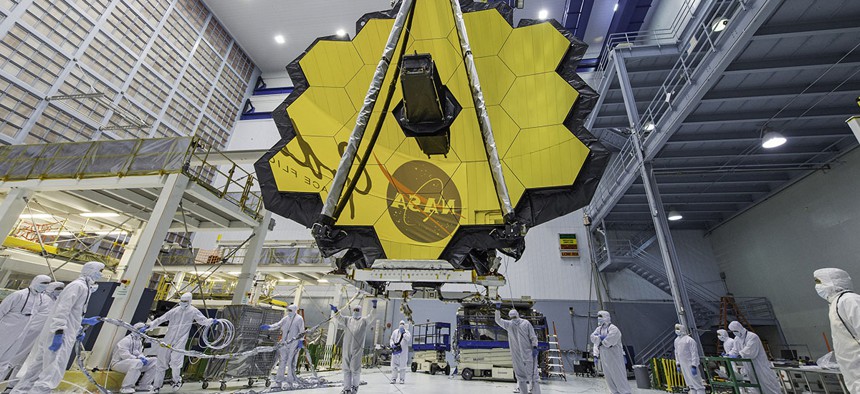Why Is NASA's Space Telescope Running a Year Behind?

NASA technicians lift the mirror of the James Webb Space Telescope using a crane at the Goddard Space Flight Center in Greenbelt, Md. NASA/AP
The James Webb will launch in 2020 instead of next year—and it will probably need more money from Congress to do it.
For the world’s most powerful space telescope, the finish line keeps getting further and further away.
The launch of the James Webb Space Telescope, the successor to the famed Hubble, has been pushed back about a year, from spring 2019 to May 2020, NASA officials said Tuesday.
The delay is NASA’s second in six months for the Webb, an ambitious, $8.8 billion project two decades in the making. And there had been other delays in the past. But this slip in the schedule is the most perilous so far.
The new delay means that the Webb project risks spending more money than it has to spend. When Webb was first proposed in 1996, officials estimated the space observatory would cost between $1 billion to $3.5 billion. Costs ballooned over the years, so in 2011, Congress mandated that NASA should not exceed a total of $8 billion for the development-and-construction phase of the mission. But the longer this phase takes, the more it will cost.
NASA and independent review boards are working on a report to present to Congress this summer about the reasons for the new launch target and “any resulting cost increase,” said Thomas Zurbuchen, the associate administrator for nasa’s Science Mission Directorate, during a press teleconference Tuesday. “We don’t really fully know what the exact cost will be,” Zurbuchen said, but “if we go one dollar over, we will be in a breach condition.”
If that happens, Webb will need to receive renewed authorization from Congress to move forward.
This latest delay doesn’t come as a surprise. In February, a report from the Government Accountability Office, a government agency that audits federal programs, found that “based on the amount of work NASA has to complete before JWST is ready to launch ... it’s likely the launch date will be delayed again.” The project was simply running out of time. After a delay was announced in September, the project was left with just one and a half months of “schedule reserves,” time to address delays or unexpected problems, the report said.
So, what went wrong?
NASA said Tuesday the delay was caused by a mix of “avoidable technical errors” and estimates for testing that proved too optimistic.
“Frankly, the tasks are taking longer to complete than we expected,” said Robert Lightfoot, who has served as NASA’s acting administrator since the start of the Trump administration.
The James Webb Space Telescope, once completed, will be a complex amalgamation of several parts. There are the 18 gleaming, gold-plated mirrors that will allow the space observatory to pick up on the faint light of the most distant stars and galaxies. There’s an instrument module, which contains four scientific devices to process what the mirrors see. And there’s what NASA calls the spacecraft element, which consists of a five-layer, tennis-court-sized sun shield that will help Webb cool down enough to work, along with a spacecraft bus, which will house the observatory’s computer systems and solar panels.
The hardware for the telescope elements—the mirrors, the scientific instruments—is all done and has undergone rigorous testing to ensure it can survive both a violent rocket launch into orbit and the extreme conditions of space. The problems seem to stem from the spacecraft element. The sun shield and bus are being developed by Northrop Grumman, the mission’s contractor, and it doesn’t sound like it’s gone well.
NASA officials said Tuesday that the sun shield developed too much slack, which created “a snagging hazard.” Several tears, some as big as four inches across, appeared on the shield and had to be repaired. Springs were added to ensure the sun shield wouldn’t sag. “I can’t say for sure whether they would or would not have caused deployment concerns in orbit,” said Dennis Andrucyk, the deputy associate administrator for the Science Mission Directorate. “But there is that risk.”
There were also errors in testing of the propulsion systems, some of which led to leaks “as well as other mishandling of these systems,” Zurbuchen said.
Officials said they overestimated how long it would take to practice the deployment sequence of the Webb, which will launch curled up and then unfurl once in orbit. A process they expected to require two weeks, for example, ended up taking a month.
NASA announced some measures they would take at Northrop Grumman’s facility in California, where all of Webb’s parts currently reside. The space agency said they will increase engineering oversight at the facility in Redondo Beach and will track the company’s test reports on a weekly basis. Senior management from NASA’s Goddard Space Flight Center in Maryland, where much of the telescope was constructed, will work out of Northrop Grumman’s offices on a permanent basis. Northrop Grumman’s project manager for Webb will report directly to C-suite level executives at the company “to help remove roadblocks to success within the company,” the officials said.
Altogether, these small fixes point to a big problem. Some of the issues with the Webb project, they suggest, are the fault of Northrup Grumman. The gao report suggested as much last month, saying that for several years “the prime contractor has overestimated workforce reductions, and technical challenges have prevented these planned reductions, necessitating the use of cost reserves.”
To get Webb to the finish line, NASA seems to have decided it has to get more involved in its contractor’s operations than ever before.
Northrop Grumman said in a statement the company “remains steadfast in its commitment to NASA and ensuring successful integration, launch and deployment” of Webb.
The next few months may be some of the most consequential for the Webb mission. The project is not out of the woods yet when it comes to testing the space observatory. The spacecraft element—the sun shield and the bus—still has to undergo the same kind of environmental testing that the telescope element already experienced. The process is expected to take a few months. Engineers will then put Webb all together and test it as one, making sure that all components work.
NASA said Tuesday it’s setting up an independent review board chaired by Tom Young, a NASA veteran. The recommendation from this committee and other groups “will be considered by NASA as it defines a more specific launch time frame,” nasa said. The space agency will then provide an assessment to Congress. In other words, don’t etch “May 2020” in stone just yet.
The delay comes a little over a week before the deadline for submissions from astronomy proposals for Webb’s first batch of observations, leading to some pretty good but painful tweets, like this one:
Every observational astronomer today #JWST1 pic.twitter.com/cSEzbu0sjM
— Emily Levesque (@emsque) March 27, 2018
There is no question that the Webb will launch someday. NASA has already invested $7.3 billion in the project, so to kill the space telescope now, after 20 years, would be to waste all that money.
But these technical issues sound particularly distressing when you consider just how complex Webb’s deployment process will be. Once in space, the space observatory will spend about two weeks unfurling into shape, all the while making course corrections as it settles into its orbit around the sun. The process is completely automated and involves about 180 deployments.
NASA officials have said Webb can only withstand the failure of about six steps in this sequence. If something goes wrong, there’s nothing anyone can do back on the ground. Unlike Hubble, Webb is not built to receive repair crews, and at nearly 1 million miles from Earth, it’s too far for astronauts to reach. Mistakes on the ground are far easier to deal with than errors in space.




